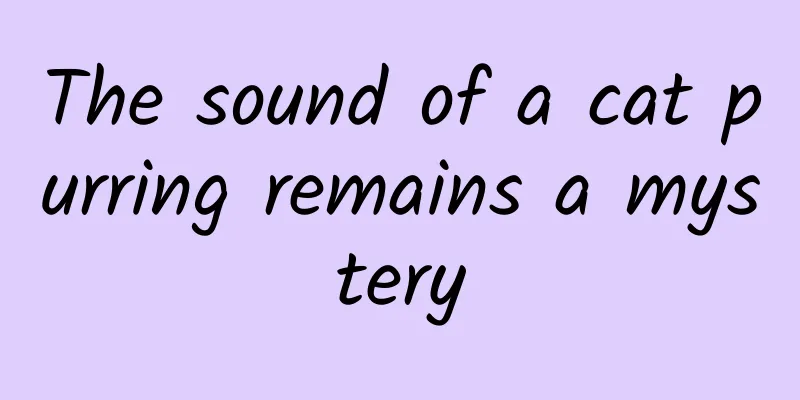The sound of a cat purring remains a mystery

|
© Hella Health Leviathan Press: Patting the buttocks, stroking the chin... these actions may make your pet purr pleasantly. Of course, cats also seem to purr when they are satisfied, such as when stepping on milk. However, as humans, we are confused about the true meaning of cats' "ventriloquism": it seems to be a resonance from the depths of the universe. Although we are not very clear about its specific function as a language, it has inadvertently healed the pain of many shit shovelers. Of course, even if we do decipher the meaning of purring in the future, we may still be like Wittgenstein said, "If the lion could speak, we would not understand it": if language is a referential system with its own essence, then we can understand the language of lions. But language serves (and in turn shapes) the practical needs of the life form that produces it. On the nights when I suffer from sleeplessness, melatonin, heavy blankets, and white noise don’t cut it. There’s only one cure for my affliction: my cat, Calvin, lying on my shoulder, purring me to sleep. For longtime members of the Purr Club, it's easy to see why. The purr is warm tea, a roaring stove, and fresh-baked cookies, all rolled into a fleece-lined hug; it's the auditory solace of a babbling brook; it's coffee brewing at dawn. Wailani Sung, a veterinary behaviorist at the San Francisco SPCA, says the purr personifies emotional contentment, a sign that "we're making our pets happy," and that feels pretty damn good. © Tumblr But the purr—one of the most recognizable sounds in the animal kingdom—is also one of its most mysterious. "No one knows exactly how the purr is made," says Robert Eklund, a phonetician and linguist at Linköping University in Sweden. And experts can't quite explain what the purr means. Cats purr when they're happy, but they also purr when they're anxious or scared, when they're giving birth, or even when they're dying. Cats may be the most mysterious creatures humans have ever welcomed into their homes, and the purr may be the most mysterious sound they make. © BeChewy At least there is some consensus on what a purr is.[1] In the strictest sense, the sound is a rhythmic, rumbling percolation, consistent with most typical animal vocalizations, occurring simultaneously with the inhalation and exhalation, with no pause between the sounds. Cats also keep their mouths completely closed when purring, like little feline ventriloquists; the sound emanates from the body at frequencies between 20 and 150 Hz.[2] As early as the 1960s, a scientist proposed[3] that the gurgling sound was a product of blood percolating through the vena cava, the blood vessel that carries blood back to the heart; this theory was later proven to be false[4]. Today, it is generally believed that the source of the grunting sound is the vocal cords[5]: the brain sends electrical signals to the vocal cords, causing them to open and close like tiny muscular doors. Many animals can imitate purring, including bears and guinea pigs. But only a few can produce a true gurgling, bubbling sound: Besides house cats, civets (a kitten-like animal native to Africa) can purr, as can lynxes, ocelots, and dozens of other smaller members of the cat family. Eklund told me about how a captive cheetah, Caine, purred constantly “from the moment he woke up to the moment he fell asleep.” However, lions, tigers, and jaguars are unable to make the same noise (I checked some videos and found that lions appear to make similar purring noises, too; editor’s note) ; and scientists have yet to find evidence that any cat species can purr and roar at the same time.[6] Scientists aren't sure what distinguishes purrs from non-purrs. It could have something to do with the length, shape, or thickness of some species' vocal cords, or the structure of the tissue around them. Or it could be the stickiness of their hyoid bones, a U-shaped bone that hangs from the throat. Or it could have nothing to do with it. Studying purrs isn't easy: Cats don't usually like to make the sound in labs, around researchers. Whatever the mechanism of purring is, it seems to be a natural ability for some cats. They start revving their little motors within days of leaving the womb, when they are still blind and deaf. According to Hazel Carney, a feline veterinarian and purring expert in Idaho, kittens and their mothers seem to use purring to each other as an early form of communication, exchanging important messages like "I'm hungry" and "Hey, mommy's here." She has three cats in Idaho—Wyatt Earp, Calamity Jane, and Hi Ho Silver. These early, positive associations may partly explain why the purring persists into adulthood, recurring whenever the cats are content—when they curl up with their favorite human, for example, or consume a particularly tasty snack. Zazie Todd, an animal behavior expert and author of Purr: The Science of Making Your Cat Happy, told me that one of her cats, Harley, sometimes purrs the moment Todd steps into the room, and that’s “super cute.” For other cats, Song told me, sometimes all it takes is eye contact with a beloved human to get the purr engine going. But the purring engine can also kick in in less pleasant situations. Mikel Delgado, a feline behavior expert in California, told me that she once had a cat that purred at the vet. Song has even heard it while inserting a catheter in a feline patient. Scientists can only speculate. For some animals, purring can be a vocal “twitch,” like nervous laughter, Carney told me; a cat could also be trying to send a distress or warning message to anyone who dares to get too close. Or, according to Jill Caviness, a veterinarian and feline expert at the University of Wisconsin-Madison who owns a cat named Electron, purring in dire situations can be a form of self-soothing. They could even be an attempt by a cat to trick its aching body into a less stressed state. © Tenor In a study in the early 2000s, one researcher suggested[7] that purring might even have a pain-relieving effect on cats—perhaps the vibrations from a purr could speed up the healing of a wound or broken bone, for example. Eklund told me that this idea wasn’t completely crazy. Vibration therapy has shown some promise in animals such as rabbits; even NASA has conducted research into it in the hope of slowing or even reversing the bone loss that occurs in astronauts after long periods of space travel. Carney told me that she has had many cat owners who “swear that their cat purred beside them in bed when they were sick and it saved their lives.” Although cats can purr at some of the same frequencies used in vibration therapy, none of these therapies have been studied with felines. “I don’t think we’ve ever done a study like, ‘I had a cat purr on my broken leg for 15 minutes a day, and I healed faster than anyone else,’ ” Kavanis told me. As for the effects of purring on the cats themselves, we have no such studies. © Meowingtons Carney is more open to the idea that purring has therapeutic properties, although she acknowledges that if people feel more comfortable around their cats, this is less likely to be due to the direct mechanical effects of purring on human tissue and more to the psychological comfort of companion animals as a whole. Eklund told me that there’s something of a boom in the study of cat communication right now, with new papers on the subject “appearing basically every week,” so a cat’s purr may be more intelligible than ever before. But compared with other cat meows, its rumblings remain unusually hard to parse, not least because purrs sound so similar in different contexts. Meows are a little tricky, too, but they have a more obvious logic: It's not hard to tell Calvin's "Feed me, I'm starving!" whimpers from his "Why am I in this cat cage?" howls. Carney, who has heard a variety of purrs over the years, told me that this distinction may also exist among purrs: contented purrs tend to be more melodious and low-pitched, while anxious purrs tend to be higher-pitched and harsher. A study a few years ago[8] showed that humans can distinguish the "pleading" purr—the sharp, high-pitched sound that cats make when they are seeking food—from the other purrs that their pets make. But distinctions like these can be difficult to discern, especially with unfamiliar cats; Kavenis said that even her veterinary students can't tell the difference in the clinic. © Imgur Unlike many other cat noises, the purr is difficult for humans to imitate. We can meow back at our own cats easily; "It's like a very basic pidgin cat language," Eklund says. But the purr? Our brains and throats aren't designed for it. For me, it's a gentle tragedy: The low purrs of my two cats, Calvin and Hobbes, are letters of love, joy, happiness; they are tactile and auditory responses to my touch. They are symbols of love that I can receive but cannot give back. Specific devices and soundtracks can provide alternatives. Some veterinary clinics play cat music in the exam room, with a bass track that sounds like a calming purr; Delgado mentions that a shelter she once worked at purchased surrogate-care machines for abandoned kittens that were equipped with a synthetic purr. Purring enthusiasts can even play a 30-minute podcast of a cat purring from an Irish orange cat named Bilbo.[9] © Tenor/Reader's Digest Purring is a language barrier we have yet to overcome. In a way, it’s very cat-like. Humans have spent generations breeding dogs to express emotions in very human ways, with soulful eyes and wet, smiling mouths.[10] Yet cats remain so nuanced; their faces have not evolved to express overt expressions, but still default to “calm cat face.” Even compared to other cat sounds, a cat’s purr is subtle and intimate, a form of communication that depends on a person’s level of closeness, intimacy, and understanding of their cat’s needs—and, perhaps, sometimes, their understanding of our needs. References: [1]meowsic.se/catvoc.html [2]citeseerx.ist.psu.edu/viewdoc/download?doi=10.1.1.1084.7703&rep=rep1&type=pdf [3]pubmed.ncbi.nlm.nih.gov/5177190/ [4]citeseerx.ist.psu.edu/viewdoc/download?doi=10.1.1.417.1307&rep=rep1&type=pdf [5]zslpublications.onlinelibrary.wiley.com/doi/abs/10.1111/j.1469-7998.1991.tb04749.x [6]purring.org [7]asa.scitation.org/doi/abs/10.1121/1.4777098 [8]www.sciencedirect.com/science/article/pii/S0960982209011683 [9]thegoodboy.cat/bilbcast [10]www.pbs.org/wgbh/nova/article/puppy-dog-eyes/ By Katherine J. Wu Translated by Kushan Proofreading/Rabbit's Light Footsteps Original article/www.theatlantic.com/science/archive/2022/09/why-cats-purr-vocalization-science/671358/ This article is based on the Creative Commons License (BY-NC) and is published by Kushan on Leviathan The article only reflects the author's views and does not necessarily represent the position of Leviathan |
<<: Why do ducklings swim in a straight line?
>>: How to descend from the sky scientifically?
Recommend
Cocos training stationed in Ledong Excellence to teach and inspire the scene
On May 15, the senior Cocos development team visi...
Apple, Google and other technology stocks plummeted: cooling down the trillion-dollar market value may not be a bad thing
Recently, high-tech stocks represented by Apple, F...
Why is "Airbus" a Chinese scam that fooled many media outlets?
If I tell you that a technological invention that...
After testing hundreds of pieces, many families still use these high-risk products
"Dad's Laboratory" has been providi...
Led by Chinese scientists, Einstein's predictions were confirmed!
The black hole that humans "saw" for th...
Is Tik Tok not operating well? Try these 9 operating tips
Anyone who understands the commercial value of Do...
Tencent fully discloses its VR plan for the first time, and its ambition is no less than the next WeChat
In the relatively "chaotic" and stalema...
The risk of death dropped by 12%! Loving to post on WeChat Moments can actually make you live longer?
Recently, we often see heated discussions on the ...
Analysis of Zhihu marketing in men’s skin care products
"Male beauty economy" is an industry te...
It is not recommended to choose a 5000mAh large battery phone when changing phones. There are three main reasons. Those who understand will understand.
There are indeed some mobile phones with large-ca...
Interpreting the “Ten Articles of WeChat”, what changes have they brought?
At present, instant messaging tools represented b...
The temperature drops sharply, and the mortality rate of this disease is higher in winter! How to prevent it is to do these 6 things!
A few days ago, I received such a patient, 62-yea...
The media reported that India's unemployment rate is high and young people are keen on starting their own businesses. Netizens complained that this is following China's footsteps.
In January 2017, the number of employed people in...
One more reason to eat spicy food! Doctors say eating spicy food has nothing to do with hemorrhoids...
Hemorrhoids, it's a bit hard to talk about Th...
What?! There are benefits to being hungry?
Since I was a kid, I have heard my elders say: &q...

![[Recommendation] Let’s talk about the strategies that need to be adopted in different operation stages!](/upload/images/67cc3d03263cf.webp)







